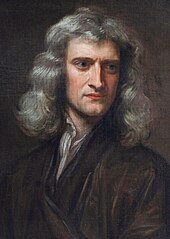Aether (classical element)
| Classical elements |
|---|
According to ancient and
Mythological origins
The word αἰθήρ (aithḗr) in
Fifth element

In
Aether differed from the four terrestrial elements; it was incapable of motion of quality or motion of quantity. Aether was only capable of local motion. Aether naturally moved in circles, and had no contrary, or unnatural, motion. Aristotle also stated that celestial spheres made of aether held the stars and planets. The idea of aethereal spheres moving with natural circular motion led to Aristotle's explanation of the observed orbits of stars and planets in perfectly circular motion.[1][11]
Medieval scholastic philosophers granted aether changes of density, in which the bodies of the planets were considered to be more dense than the medium which filled the rest of the universe.[12] Robert Fludd stated that the aether was "subtler than light". Fludd cites the 3rd-century view of Plotinus, concerning the aether as penetrative and non-material.[13]
Quintessence



Quintessence (𝓠) is the
This elemental system spread rapidly throughout all of Europe and became popular with alchemists, especially in medicinal alchemy. Medicinal alchemy then sought to isolate quintessence and incorporate it within medicine and elixirs.
Legacy
With the 18th century physics developments, physical models known as "aether theories" made use of a similar concept for the explanation of the propagation of electromagnetic and gravitational forces. As early as the 1670s, Newton used the idea of aether to help match observations to strict mechanical rules of his physics.[18][a] The early modern aether had little in common with the aether of classical elements from which the name was borrowed. These aether theories are considered to be scientifically obsolete, as the development of special relativity showed that Maxwell's equations do not require the aether for the transmission of these forces. Einstein noted that his own model which replaced these theories could itself be thought of as an aether, as it implied that the empty space between objects had its own physical properties.[20]
Despite the early modern aether models being superseded by general relativity, occasionally some physicists have attempted to reintroduce the concept of aether in an attempt to address perceived deficiencies in current physical models.[21] One proposed model of dark energy has been named "quintessence" by its proponents, in honor of the classical element.[22] This idea relates to the hypothetical form of dark energy postulated as an explanation of observations of an accelerating universe. It has also been called a fifth fundamental force.
Aether and light
The motion of light was a long-standing investigation in physics for hundreds of years before the 20th century. The use of aether to describe this motion was popular during the 17th and 18th centuries, including a theory proposed by Johann II Bernoulli, who was recognized in 1736 with the prize of the French Academy. In his theory, all space is permeated by aether containing "excessively small whirlpools". These whirlpools allow for aether to have a certain elasticity, transmitting vibrations from the corpuscular packets of light as they travel through.[23]
This theory of
Aether and gravitation
In 1682,

A few years later, aether was used in one of Sir Isaac Newton's first published theories of gravitation, Philosophiæ Naturalis Principia Mathematica (the Principia, 1687). He based the whole description of planetary motions on a theoretical law of dynamic interactions. He renounced standing attempts at accounting for this particular form of interaction between distant bodies by introducing a mechanism of propagation through an intervening medium.[27] He calls this intervening medium aether. In his aether model, Newton describes aether as a medium that "flows" continually downward toward the Earth's surface and is partially absorbed and partially diffused. This "circulation" of aether is what he associated the force of gravity with to help explain the action of gravity in a non-mechanical fashion.[27] This theory described different aether densities, creating an aether density gradient. His theory also explains that aether was dense within objects and rare without them. As particles of denser aether interacted with the rare aether they were attracted back to the dense aether much like cooling vapors of water are attracted back to each other to form water.[28] In the Principia he attempts to explain the elasticity and movement of aether by relating aether to his static model of fluids. This elastic interaction is what caused the pull of gravity to take place, according to this early theory, and allowed an explanation for action at a distance instead of action through direct contact. Newton also explained this changing rarity and density of aether in his letter to Robert Boyle in 1679.[28] He illustrated aether and its field around objects in this letter as well and used this as a way to inform Robert Boyle about his theory.[29] Although Newton eventually changed his theory of gravitation to one involving force and the laws of motion, his starting point for the modern understanding and explanation of gravity came from his original aether model on gravitation.[30][self-published source?]
See also
References
Footnotes
Citations
- ^ ISBN 0-521-09456-9,
Believing that the movements of the heavenly bodies are continuous, natural and circular, and that the natural movements of the four terrestrial elements are rectilinear and discontinuous, Aristotle concluded that the heavenly bodies must be composed of a fifth element, aither [sic].
- ^ Carl S. Helrich, The Classical Theory of Fields: Electromagnetism Berlin, Springer 2012, p. 26.
- ISBN 978-0-674-98516-2.
- ISBN 0802088503.
- ^ "AITHER". AETHER : Greek protogenos god of upper air & light; mythology : AITHER. Retrieved January 16, 2016.
- ^ Pokorny, Julius (1959). Indogermanisches etymologisches Wörterbuch, s.v. ai-dh-.
- ^ Αἰθίοψ in Liddell, Scott, A Greek–English Lexicon: "Αἰθίοψ, οπος, ὁ, fem. Αἰθιοπίς, ίδος, ἡ (Αἰθίοψ as fem., A.Fr.328, 329): pl. 'Αἰθιοπῆες' Il.1.423, whence nom. 'Αἰθιοπεύς' Call.Del.208: (αἴθω, ὄψ):— properly, Burnt-face, i.e. Ethiopian, negro, Hom., etc.; prov., Αἰθίοπα σμήχειν 'to wash a blackamoor white', Luc.Ind. 28." Cf. Etymologicum Genuinum s.v. Αἰθίοψ, Etymologicum Gudianum s.v.v. Αἰθίοψ. "Αἰθίοψ". Etymologicum Magnum (in Greek). Leipzig: Lipsiae Apud J.A.G. Weigel. 1818.
- ISBN 9781317797272. Retrieved 20 January 2015.
...[Africa's Indian Ocean] coast was called Azania, and no 'Ethiopeans', dark skinned people, were mentioned amongst its inhabitants.
- ^ Plato, Timaeus 58d.
- S2CID 170926485.
- ^ George Smoot III. "Aristotle's Physics". lbl.gov. Archived from the original on 20 December 2016. Retrieved 20 December 2016.
- ISBN 978-0-521-56509-7.
- ^ Robert Fludd, "Mosaical Philosophy". London, Humphrey Moseley, 1659, p. 221.
- ^ B.J.T. Dobbs (1983) The Foundations of Newton's Alchemy, p. xiv.
- ^ a b The Alchemists, F. Sherwood Taylor, page 95.
- ^ The book of Quintessence Archived 2015-09-24 at the Wayback Machine, Early English Text Society original series number 16, edited by F. J. Furnivall.
- ^ The Dictionary of Alchemy, Mark Haeffner.
- ^ Margaret Osler, Reconfiguring the World. The Johns Hopkins University Press 2010. (155).
- ISBN 0-691-02350-6.
- ^ Einstein, Albert: "Ether and the Theory of Relativity" (1920), republished in Sidelights on Relativity (Methuen, London, 1922)
- S2CID 4288946.
- S2CID 119073006.
- ^ Whittaker, Edmund Taylor, A History of the Theories of Aether and Electricity from the Age of Descartes to the Close of the 19th Century (1910), pp. 101-02.
- S2CID 130423116.
- .
- ^ "Bernoulli nell'Enciclopedia Treccani".
- ^ S2CID 122494617.
- ^ a b Newton, Isaac."Isaac Newton to Robert Boyle, 1679." 28 February 1679.
- ^ James DeMeo (2009). "Isaac Newton's Letter to Robert Boyle, on the Cosmic Ether of Space - 1679". orgonelab.org. Archived from the original on 20 December 2016. Retrieved 20 December 2016.
- ]
